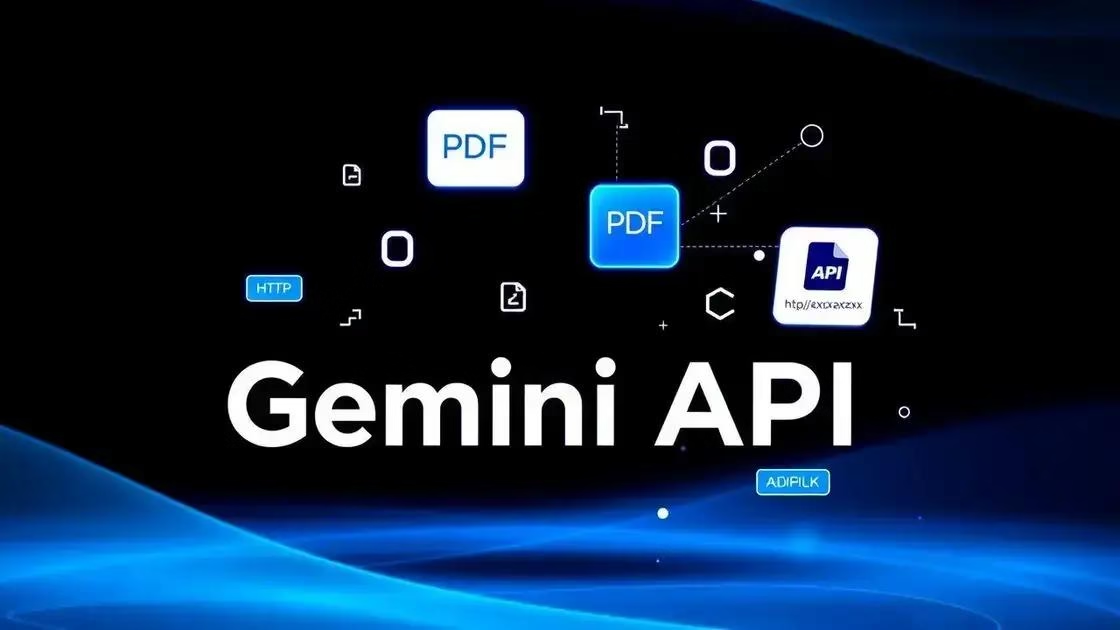The Gemini API’s new URL context tool significantly enhances AI capabilities by allowing models to directly access and understand information from web pages, including content within PDF documents and images. This powerful feature provides AI applications with real-time, up-to-date context, leading to more accurate responses and efficient data processing. Developers can leverage this tool for diverse real-world applications, from improving customer support chatbots with instant access to product manuals to streamlining content creation and market research by analyzing current web data.
The new Gemini API URL context tool revolutionizes how developers enhance their AI applications by adding context from web pages effortlessly. Imagine providing AI with real-time access to accurate data instead of visiting various pages! This tool includes exciting features such as PDF and image support, enabling richer interactions and analysis. Let’s dive deeper into its game-changing capabilities!
Overview of the URL Context Tool Features
The new URL context tool for the Gemini API is a big step forward for anyone building AI applications. It helps your AI understand web pages much better. Think of it like giving your AI a super-smart way to read and learn from websites. This tool lets developers easily add information from any web page directly into their AI models. It means the AI can get real-time facts and details without you having to manually feed it data. This makes AI apps much more powerful and accurate.
One of the coolest parts of this tool is its ability to handle different types of content. It doesn’t just read text. Now, it can also process PDF documents. This is a huge deal. Imagine an AI that can summarize a long research paper or extract specific data from a financial report, all in PDF format. Before, you might have needed complex steps to convert PDFs into text. Now, the Gemini API handles it for you. This saves a lot of time and effort for developers. It also opens up new possibilities for AI applications that deal with lots of document-based information. For example, a customer service AI could quickly find answers in a product manual that’s stored as a PDF. Or a legal AI could scan contracts for key clauses. This feature makes the AI much more versatile.
Another exciting addition is image support. This means the URL context tool can now understand what’s in pictures on a web page. It’s not just about seeing an image; it’s about getting context from it. For instance, if a web page has a diagram explaining a complex process, the AI can now use that visual information. This is a game-changer for AI models that need to interpret visual data alongside text. Think about an AI that helps with online shopping. It could look at product images on a website and understand features or styles. Or an AI for educational purposes could analyze charts and graphs from a science article. This capability helps the AI build a more complete picture of the content on a web page. It moves beyond just words to truly understanding the visual elements that often convey important information.
This tool works by letting you point your AI to a specific URL. The Gemini API then goes to that URL, reads the content, and pulls out the important bits. It then makes this information available to your AI model. This process is very efficient. It ensures that your AI always has the most current information from the web. This is much better than relying on old, pre-trained data that might be out of date. For developers, this means less time spent on data collection and more time on building smart features. It simplifies the whole process of giving your AI relevant context.
How the URL Context Tool Boosts AI Understanding
The main goal of the URL context tool is to make AI models smarter. When an AI has more context, it can give better answers and perform tasks more accurately. For example, if you ask an AI about a news event, and it can read the latest articles about that event, its response will be much more informed. This tool helps bridge the gap between static AI knowledge and the dynamic, ever-changing information on the internet. It allows AI to “browse” the web in a very focused way, pulling in exactly what it needs for a specific task. This leads to more natural and helpful interactions with AI.
Developers can use this feature in many ways. Imagine building a chatbot that can answer questions about any product on an e-commerce site. Instead of pre-loading all product details, the chatbot can simply use the URL context tool to fetch information directly from the product page when a user asks a question. This keeps the information fresh and reduces the need for constant updates to the AI’s knowledge base. Another use case could be for content creation. An AI could read several articles on a topic using the URL context tool and then generate a summary or a new piece of content based on that fresh information. This makes the AI a powerful research assistant.
The tool also helps with complex data analysis. If you have an AI designed to track market trends, it can now pull data from various financial news sites or reports. With PDF support, it can even process detailed market analyses published as documents. This gives the AI a much richer dataset to work with, leading to more insightful predictions or summaries. The ability to process both text and images means the AI can understand a wider range of information. For example, it could analyze a product review page, reading the text comments and also interpreting sentiment from user-uploaded images. This holistic understanding is what makes the Gemini API’s new tool so impactful.
Simplifying Development with Real-Time Data
One of the biggest headaches for AI developers is keeping their models updated with the latest information. The internet changes constantly. New articles, new products, new research – it’s all happening in real time. The URL context tool solves this problem. It provides a direct link to current web content. This means your AI applications can always work with the most up-to-date facts. You don’t have to worry about your AI giving outdated information. This real-time capability is crucial for applications that need to be highly responsive and accurate, like news aggregators, customer support systems, or research tools.
Integrating this tool into your existing Gemini API projects is designed to be straightforward. Google has made it easy for developers to add this powerful feature without a lot of complex coding. This means you can quickly enhance your AI applications. It’s about making AI more accessible and more useful for a wider range of tasks. The tool handles the heavy lifting of web scraping and data extraction. This frees up developers to focus on the unique logic and user experience of their AI applications. It’s a true accelerator for AI development.
In summary, the URL context tool for the Gemini API is a game-changer. It brings the vastness of the internet directly to your AI models. With support for PDFs and images, it goes beyond simple text. It allows for richer, more accurate, and more dynamic AI applications. Developers can now build AI systems that are truly informed by the latest web content, making them smarter and more helpful than ever before. This tool is a clear sign of how AI is evolving to be more integrated with the real world’s information flow. It’s an exciting time for AI development, and this tool is a key part of that future.
Benefits of Using the Gemini API
The Gemini API brings many great things to the table for anyone building AI tools. It makes creating smart applications much easier and faster. One of the biggest pluses is how it helps your AI understand things better. With the new URL context tool, your AI can now read and learn from web pages just like a person would. This means your AI apps can get the most current information right when they need it. They don’t have to rely on old data. This makes the AI’s answers much more accurate and helpful.
Think about how much time developers spend gathering and preparing data. It can be a huge job. The Gemini API, especially with its URL context feature, cuts down on this work a lot. Instead of manually finding information or setting up complex systems to pull data from websites, you just point the AI to a URL. The API does the rest. It fetches the content, processes it, and makes it ready for your AI model. This saves countless hours. It lets developers focus on making their AI smarter, not just feeding it information. This boost in efficiency is a major benefit for any development team.
Another key advantage is getting real-time information. The internet is always changing. New articles, new products, and new trends pop up every second. If your AI relies on old data, it can quickly become outdated. The Gemini API helps your AI stay current. When a user asks a question, the AI can quickly check the latest web pages for answers. This is super important for things like news apps, customer support chatbots, or tools that track market prices. Your AI will always have the freshest facts. This leads to better decisions and more reliable responses from your AI applications.
The new support for PDF documents is a game-changer. Many important documents, like reports, manuals, and research papers, are in PDF format. Before, getting information from these files into an AI was tricky. You often needed special tools or extra steps. Now, the Gemini API handles it directly. Your AI can read and understand content from PDFs. This opens up a whole new world of possibilities. Imagine an AI that can summarize a long legal document or pull out key figures from a financial report. This makes the AI much more powerful for businesses that deal with lots of documents. It helps them automate tasks that used to take a lot of human effort.
Similarly, image support adds another layer of understanding. Web pages aren’t just text; they have pictures, charts, and diagrams. These visuals often carry important information. The Gemini API’s URL context tool can now process these images. It helps the AI understand what’s shown in a picture and how it relates to the text. For example, an AI helping with medical queries could look at a diagram of the human body. Or an AI for home improvement could understand a picture of a broken pipe. This visual understanding makes the AI’s knowledge much richer. It allows for more complete and accurate responses, as the AI can combine both text and visual cues.
Using the Gemini API also means your AI applications can be more versatile. Because they can pull context from so many different sources – web pages, PDFs, images – they can handle a wider range of tasks. A single AI model could potentially serve multiple purposes. For instance, a customer service AI could answer questions from a product page, then check a PDF manual for troubleshooting steps, and even look at a user-uploaded image of a problem. This flexibility makes the Gemini API a powerful tool for building all sorts of innovative applications. It reduces the need for many specialized AIs.
Furthermore, the Gemini API is designed to be easy to integrate. Google has made sure that developers can add these powerful features to their existing projects without too much trouble. This means you can quickly upgrade your AI apps. You don’t need to rewrite everything from scratch. This ease of use speeds up the development process. It allows teams to bring new, smarter features to market faster. This is a big win for businesses looking to stay ahead in the fast-moving world of AI. It lowers the barrier for entry into advanced AI development.
Finally, using the Gemini API helps foster innovation. With such powerful tools at their fingertips, developers can think of new ways to use AI. They can create applications that were simply not possible before. Imagine an AI that can research a topic, summarize findings from various sources (including PDFs and images), and then generate a detailed report. Or an AI that can monitor online trends by analyzing both text and visual content across many websites. The possibilities are endless. The Gemini API gives developers the building blocks to create truly groundbreaking AI solutions. It empowers them to push the boundaries of what AI can do. This leads to exciting new products and services that can change how we work and live.
The benefits of using the Gemini API are clear. It makes AI smarter, development faster, and applications more versatile. It helps AI stay current with real-time web information, including complex documents and images. For any developer looking to build cutting-edge AI, the Gemini API offers a robust and powerful platform. It’s designed to simplify complex tasks and unlock new levels of AI capability. This means better AI for everyone, from businesses to everyday users. It’s a tool that truly helps AI reach its full potential.
Real-World Applications of the URL Context Tool
The new URL context tool for the Gemini API isn’t just a fancy feature. It’s a real game-changer for how AI can help us every day. This tool lets AI models understand and use information directly from the internet. This includes regular web pages, but also tricky things like PDF documents and even images. Let’s look at some cool ways this tool is already making a difference in the real world. It shows how AI can become much smarter and more helpful.
Boosting Customer Support with Smart Chatbots
Imagine you’re trying to figure out how to use a new gadget. You go to the company’s website and ask a chatbot for help. Before, the chatbot might only know what was programmed into it. Now, with the URL context tool, that chatbot can instantly read the product’s official web page. It can even pull details from the product’s PDF user manual. This means you get accurate, up-to-date answers right away. The chatbot can look at diagrams in the manual (thanks to image support) to explain things better. This makes customer service much faster and more helpful. Companies can save money because their AI can handle more questions without needing a human agent. It’s a win-win for both customers and businesses.
Making Content Creation Easier and Faster
For writers, researchers, or anyone who creates content, this tool is a dream. Think about writing an article on a new topic. You’d normally spend hours searching different websites, reading articles, and looking at reports. Now, an AI powered by the Gemini API can do much of that work for you. You can give it a list of URLs. The AI will then read all the content, including long research papers in PDF format. It can even understand charts and graphs from images on those pages. The AI can then summarize the key points or even draft parts of your article based on this fresh information. This saves a lot of time. It also helps ensure the content is accurate and well-researched. It’s like having a super-smart research assistant that never gets tired.
Smarter Market Research and Business Analysis
Businesses need to know what’s happening in their market. They need to track trends, understand competitors, and keep an eye on news. The URL context tool makes this much easier for AI. An AI can now constantly scan news websites and industry blogs. It can pull out important details about new products or market shifts. With PDF support, it can even read detailed financial reports from competitors or market analysis documents. If there are charts or infographics in those reports, the AI can understand them too, thanks to image support. This gives businesses a huge edge. They can get real-time insights and make faster, better decisions. It helps them stay competitive and spot new opportunities before anyone else.
Revolutionizing Education and Learning Tools
Learning can be tough, especially with complex subjects. AI tools using the URL context feature can make it simpler. Imagine a student struggling with a science concept. An AI tutor could be given a link to an online textbook or a scientific article. The AI would then read that content, including any diagrams or illustrations (images), and explain the concept in simpler terms. It could even pull examples from other web pages to help the student understand better. This personalized learning experience can help students grasp difficult topics faster. For educators, it means they can create more dynamic and interactive learning materials. It makes knowledge more accessible to everyone.
Enhancing E-commerce and Shopping Experiences
Online shopping can sometimes feel overwhelming with so many choices. An AI powered by the Gemini API can make it much easier. When you’re looking at a product, the AI could instantly pull up reviews from other sites. It could compare prices across different stores. It could even analyze product images to highlight specific features or show how a product looks in different settings. For example, if you’re buying clothes, the AI could look at user-uploaded photos to show how the item fits on real people. This helps shoppers make more informed decisions. It makes the online shopping experience more personal and less stressful. Businesses can also use this to better understand what customers like and don’t like.
Streamlining Legal and Compliance Work
The legal field involves a lot of reading and understanding complex documents. Many laws, regulations, and case studies are published as PDFs. The URL context tool is a huge help here. An AI can be given access to legal databases or government websites. It can then quickly scan through thousands of pages of legal text in PDF format. It can identify key clauses, summarize important cases, or check for compliance issues. This saves legal professionals a massive amount of time. It helps them find relevant information much faster and reduces the chance of missing something important. It’s a powerful tool for research and due diligence in the legal world.
These examples show just how powerful the Gemini API’s URL context tool is. By letting AI understand and use information from web pages, PDFs, and images, it opens up a world of new possibilities. From helping customers to assisting researchers, this tool is making AI more practical and useful in our daily lives. It’s all about giving AI the right information at the right time, making it truly smart and responsive to real-world needs.
FAQ – Frequently Asked Questions about the Gemini API URL Context Tool
What is the Gemini API URL context tool?
It’s a new feature for the Gemini API that lets AI models read and understand information directly from web pages, helping them get real-time facts and details.
What types of content can the URL context tool process?
It can process regular web page text, PDF documents, and also extract context and understanding from images found on web pages.
How does the URL context tool help developers save time?
It automates the process of gathering and preparing data from websites, reducing the need for manual data collection and complex web scraping.
How does the URL context tool ensure AI models have up-to-date information?
It allows AI to fetch current content directly from URLs in real-time, ensuring the AI always works with the freshest facts from the internet.
Can the URL context tool understand images and PDFs?
Yes, it has support for processing content within PDF documents and can also interpret visual information from images on web pages.
What are some real-world applications of this tool?
It can be used to enhance customer support chatbots, streamline content creation, improve market research, and revolutionize educational and e-commerce tools.









